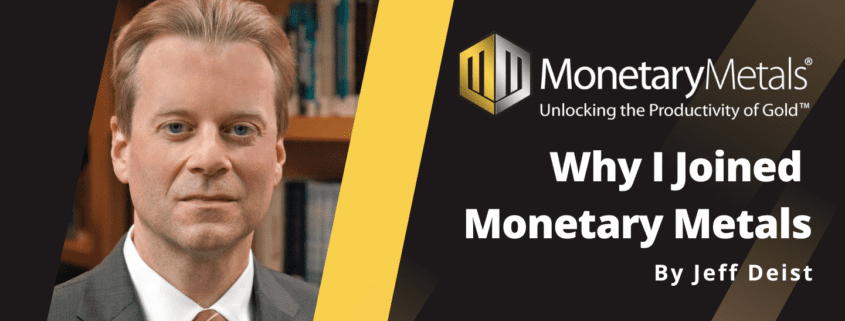Jeff Deist: Why I Joined Monetary Metals
This post was written by Jeff Deist, former President of the Mises Institute. Jeff will be joining Monetary Metals full-time as General Counsel in May.
I am exceptionally pleased to join Monetary Metals after ten years at the Mises Institute.
Offering yield on gold is both simple and yet novel in today’s modern context. Monetary Metals offers its clients meaningful returns, but it can also help the world take a much-needed step toward reasserting gold’s longstanding role as a monetary asset. And the world cries out for a truly market-based alternative to the current monetary system.
After thousands of years, the use cases for gold are obvious. Why should more than 200,000 tons of gold lie fallow, when the world is clamoring for more stable money? Why can’t physical gold be put to use as a financing option for both industrial and mining purposes? Why shouldn’t gold pay yield?
This is why Monetary Metals exists.
The potential market for both leases and bonds of physical precious metals is enormous.
At the Mises Institute, and in the preceding years working in Dr. Ron Paul’s congressional office, I focused primarily on the Federal Reserve and “monetary policy,” which I view as unnecessary and harmful. No individual, or group of individuals, have the ability and information needed to determine the proper “supply” of money and credit, or to shape interest rates. Like all economic interventions, they are inefficient at best, and ruinous at worst. I saw firsthand how monetary policy becomes a political exercise in short-term thinking and expediency. Problems go unaddressed and worsen as a result.
This background makes Monetary Metals a natural home for me.
Just 25 years ago, monetary policy was a boring backwater field even among professional economists. Alan Greenspan was The Maestro, a onetime gold advocate and inflation hawk who succumbed to the seductive allure of expanding the economy through monetary alchemy. The brilliant technocrat came to believe he could conjure prosperity—not by creating conditions for greater productivity—but by manipulating debt and dollars.
That prosperity was illusory, as demonstrated during the unholy first decade of the 2000s. Vice president Dick Cheney told us “deficits don’t matter,” even as spending skyrocketed to fund two wars and a vast new prescription drug program. But trouble brewed underneath the surface: first the dot.com implosion, then the demise of Enron and Arthur Andersen, followed by the horrific housing bubble bursting, the Lehman Brothers and Bear Stearns bankruptcies, the Countrywide Mortgage scandal, and ultimately the Global Financial Crisis.
What did we learn from that turbulent time? Not much, considering how central bankers and politicians doubled down in the following years. Since 2008, total global debt has more than doubled, from roughly $142 trillion to more than $300 trillion. Much of this increase is sovereign debt, which means big trouble for national treasuries making minimum interest payments in a rising rate environment. The balance sheets of the Fed, the ECB, and other central banks have swelled by multiples since 2007, thanks to endless asset purchases which effectively recapitalized shaky commercial banks.
Fast forward to 2020 and the Covid crisis, which led to unprecedented levels of both monetary and fiscal intervention which make the 2008 response seem mild by comparison. Yet, in spite of all this “stimulus” the shakiness remains. We’ve already seen the fallout across Silicon Valley Bank and several others, and at least one prominent pundit argues that most U.S. banks are near insolvency. The world clearly needs an alternative to the fiat orgy. Gold remains poised to reclaim a monetary role, but it needs innovative market approaches to unlock that potential.
This is why Monetary Metals exists.
America and the West can do better, and we must. Political money is leading us down a path to oblivion. The ramifications are cultural as well as financial. As my friend Saifedean Ammous explains, fiat money not only creates economic distortions, but also fiat education, fiat medicine, fiat food, and even fiat social mores. What kind of world do we intend to leave our children and grandchildren? Will we effectively steward the capital built up and bequeathed by previous generations, or consume it in an orgy of late-stage imperial delusion?
These questions remain unanswered. But we know the path forward. Menger explained the market origins of money, Mises explained the marginal value of money, and Hayek explained why money must be denationalized. If America and the West hope to regain real prosperity, it begins with empowering market forces, rather than central bank soothsayers, to shape the future of money, credit, and interest rates. I believe Monetary Metals can play an important role in that future, which is why I’m thrilled to join their enterprise and build a more peaceful and prosperous monetary future.
Additional Resources for Earning Interest on Gold
If you’d like to learn more about how to earn interest on gold with Monetary Metals, check out the following resources:
In this paper we look at how conventional gold holdings stack up to Monetary Metals Investments, which offer a Yield on Gold, Paid in Gold®. We compare retail coins, vault storage, the popular ETF – GLD, and mining stocks against Monetary Metals’ True Gold Leases.
The Case for Gold Yield in Investment Portfolios
Adding gold to a diversified portfolio of assets reduces volatility and increases returns. But how much and what about the ongoing costs? What changes when gold pays a yield? This paper answers those questions using data going back to 1972.











Leave a Reply
Want to join the discussion?Feel free to contribute!